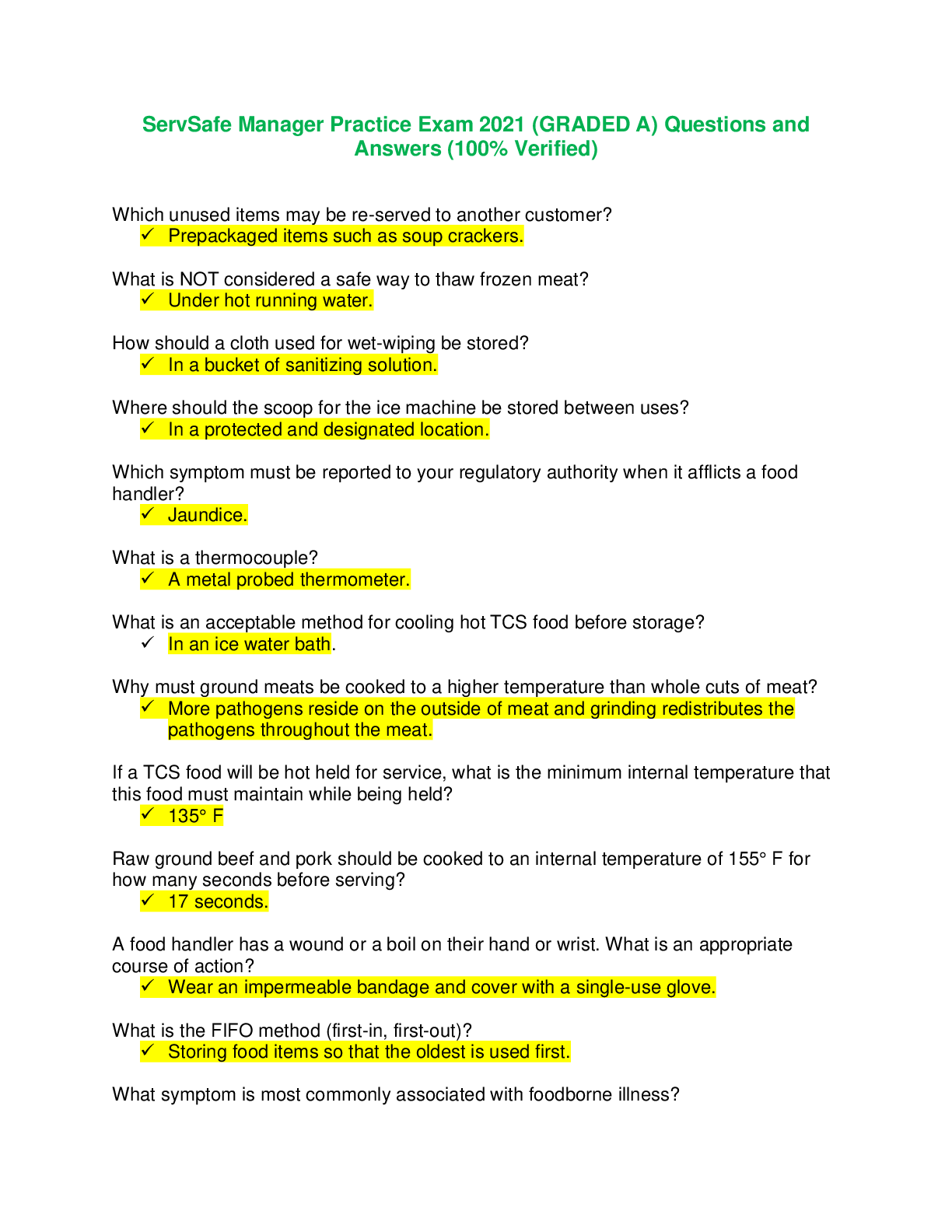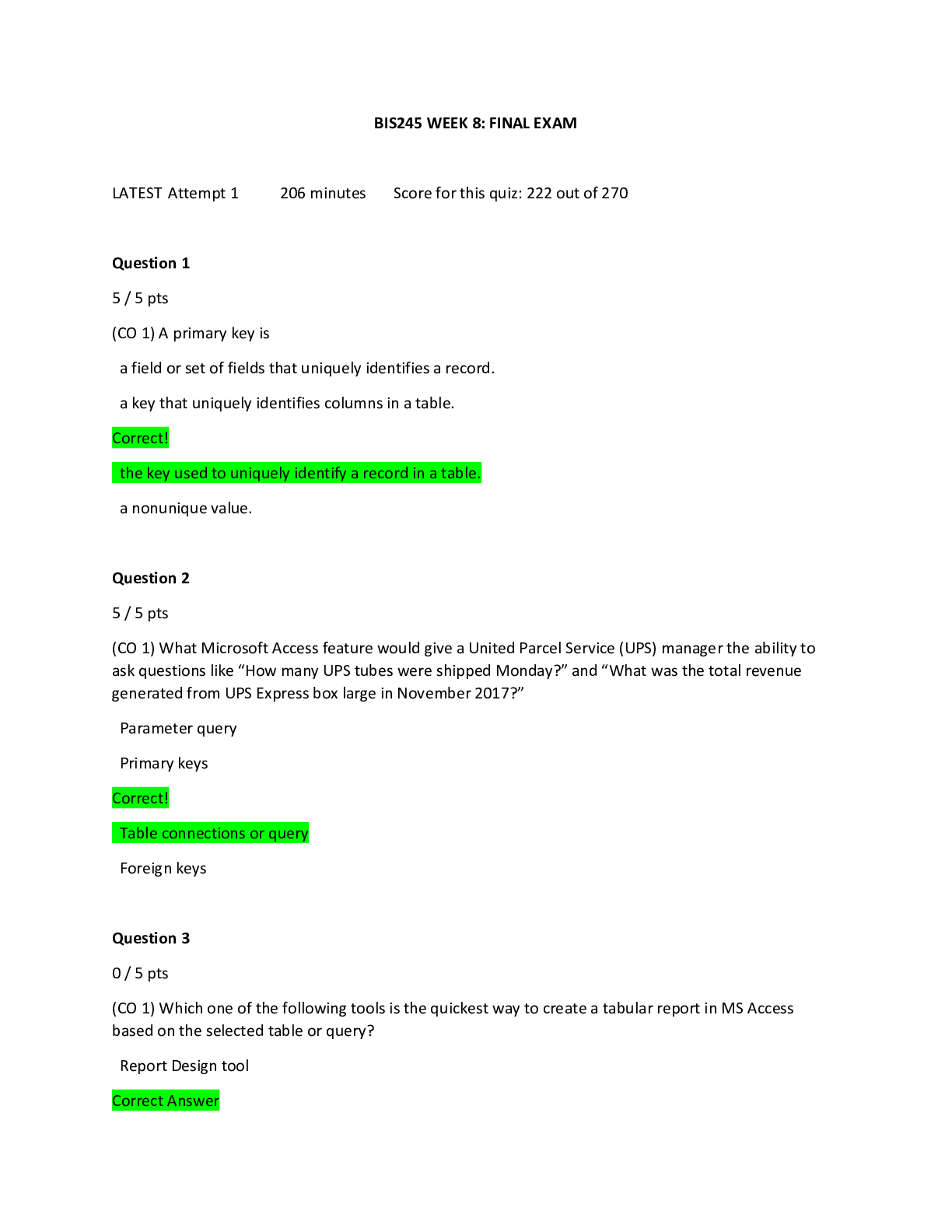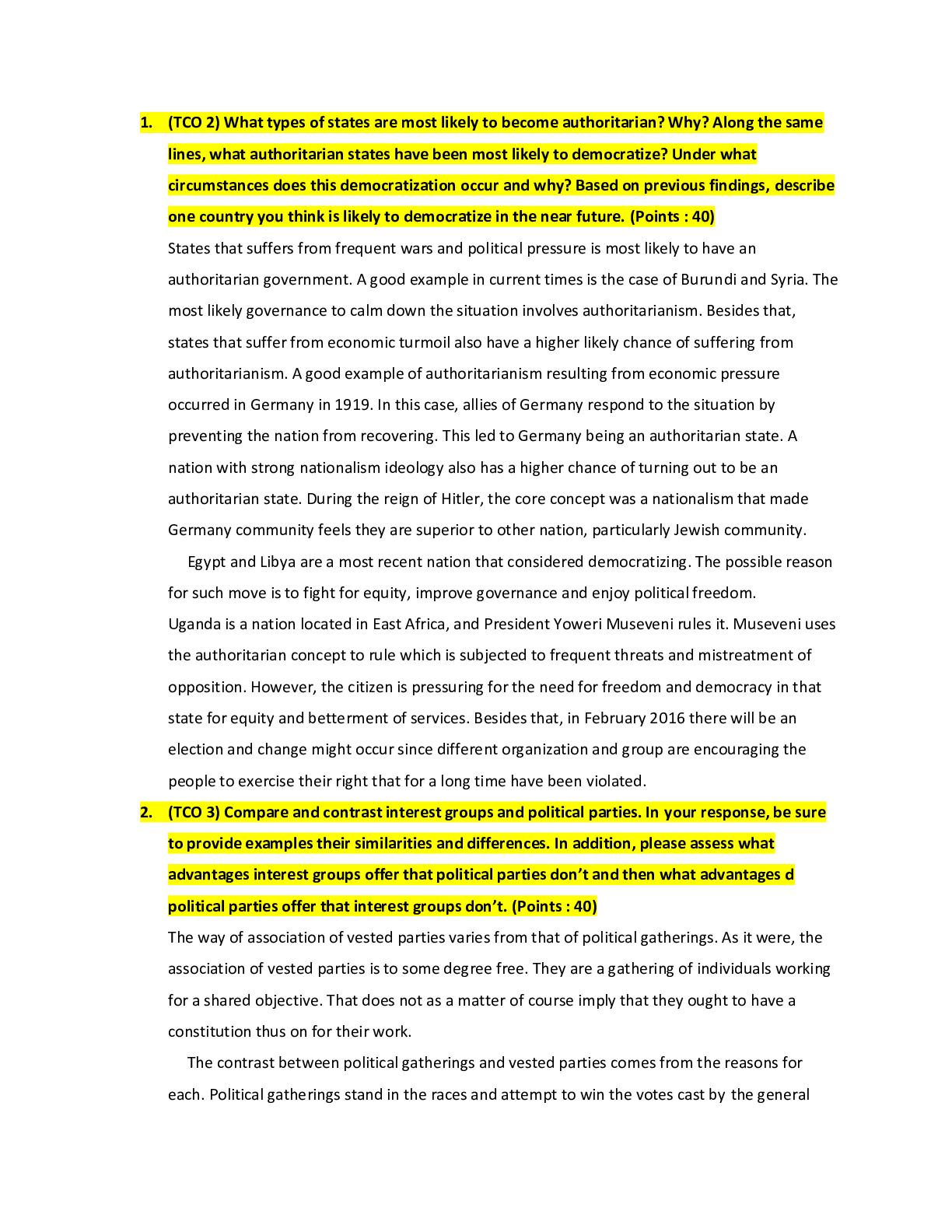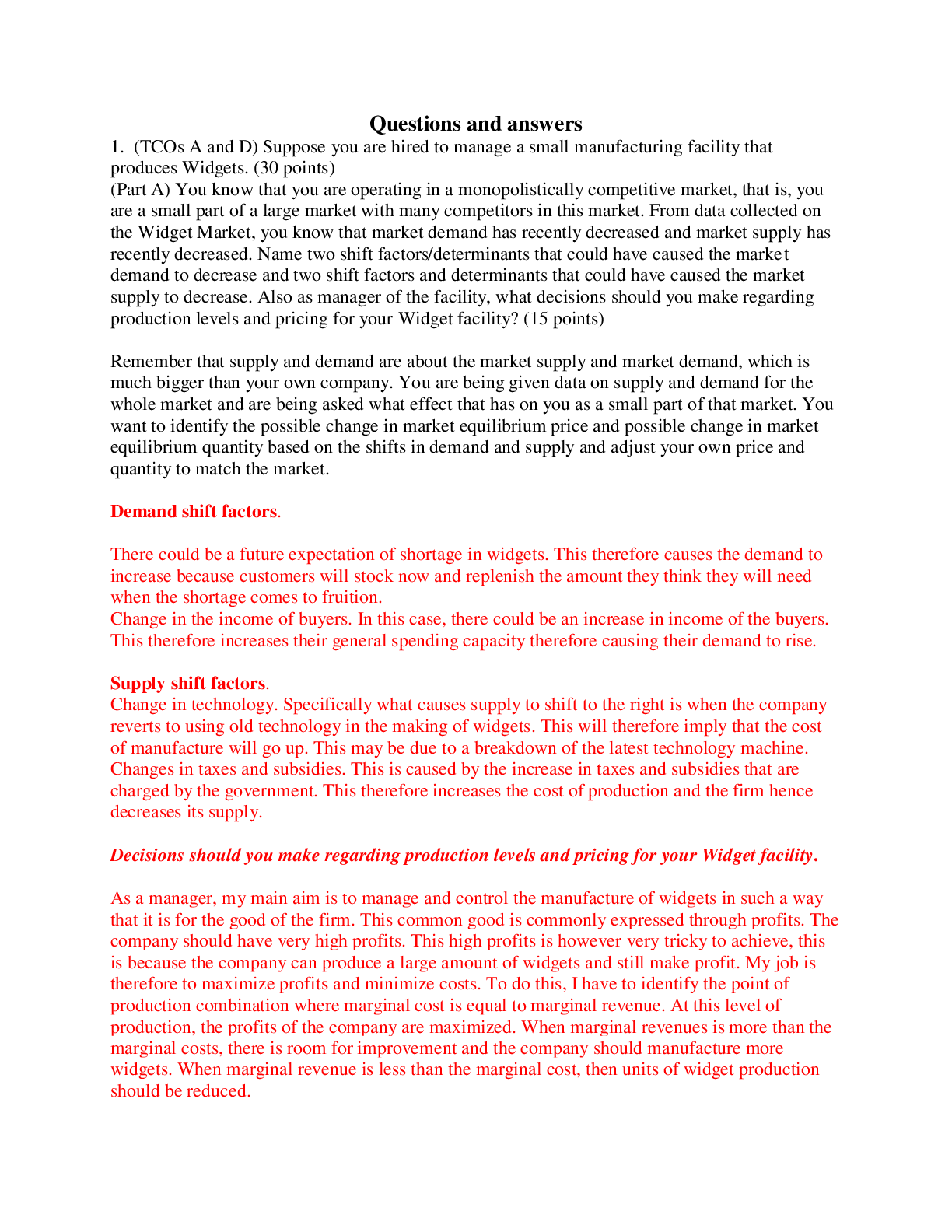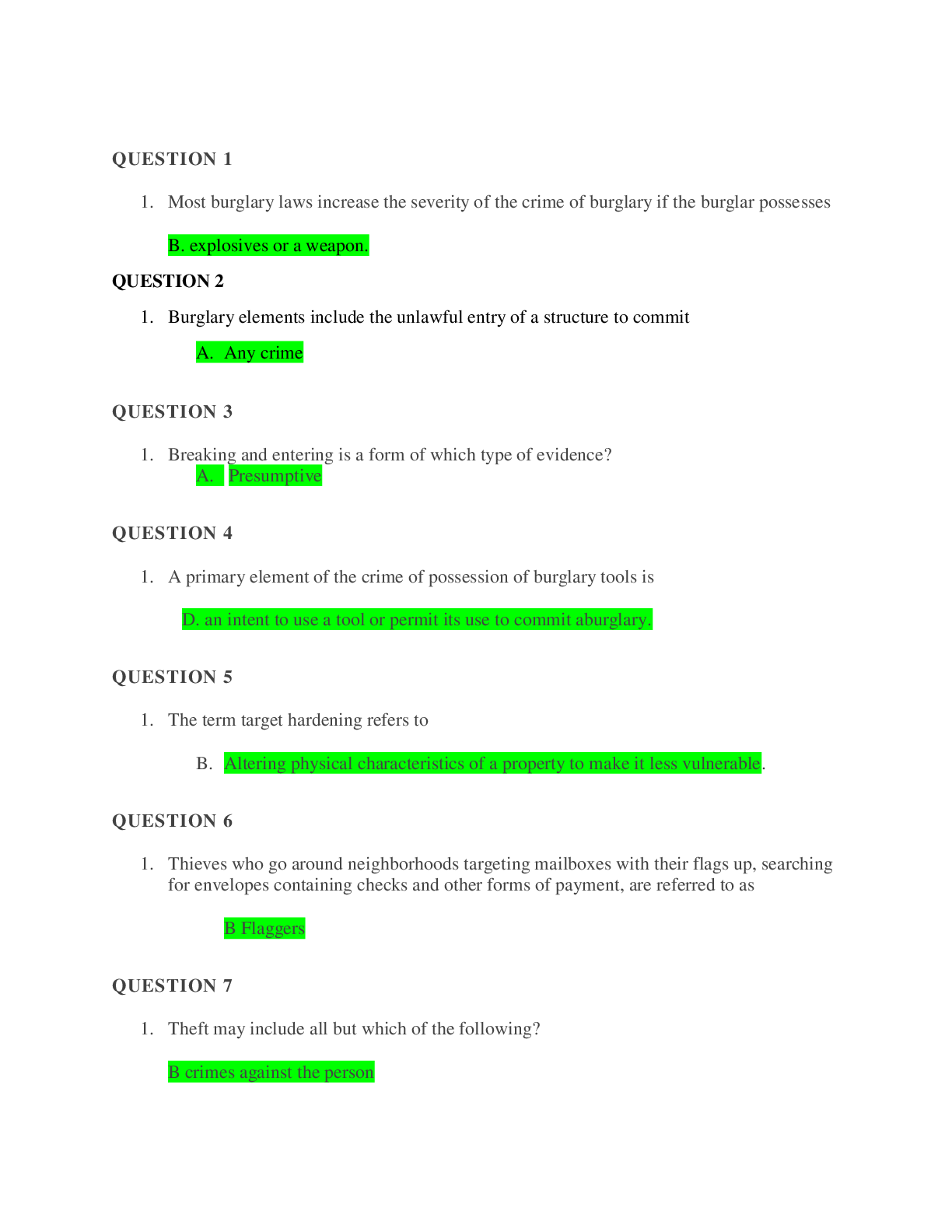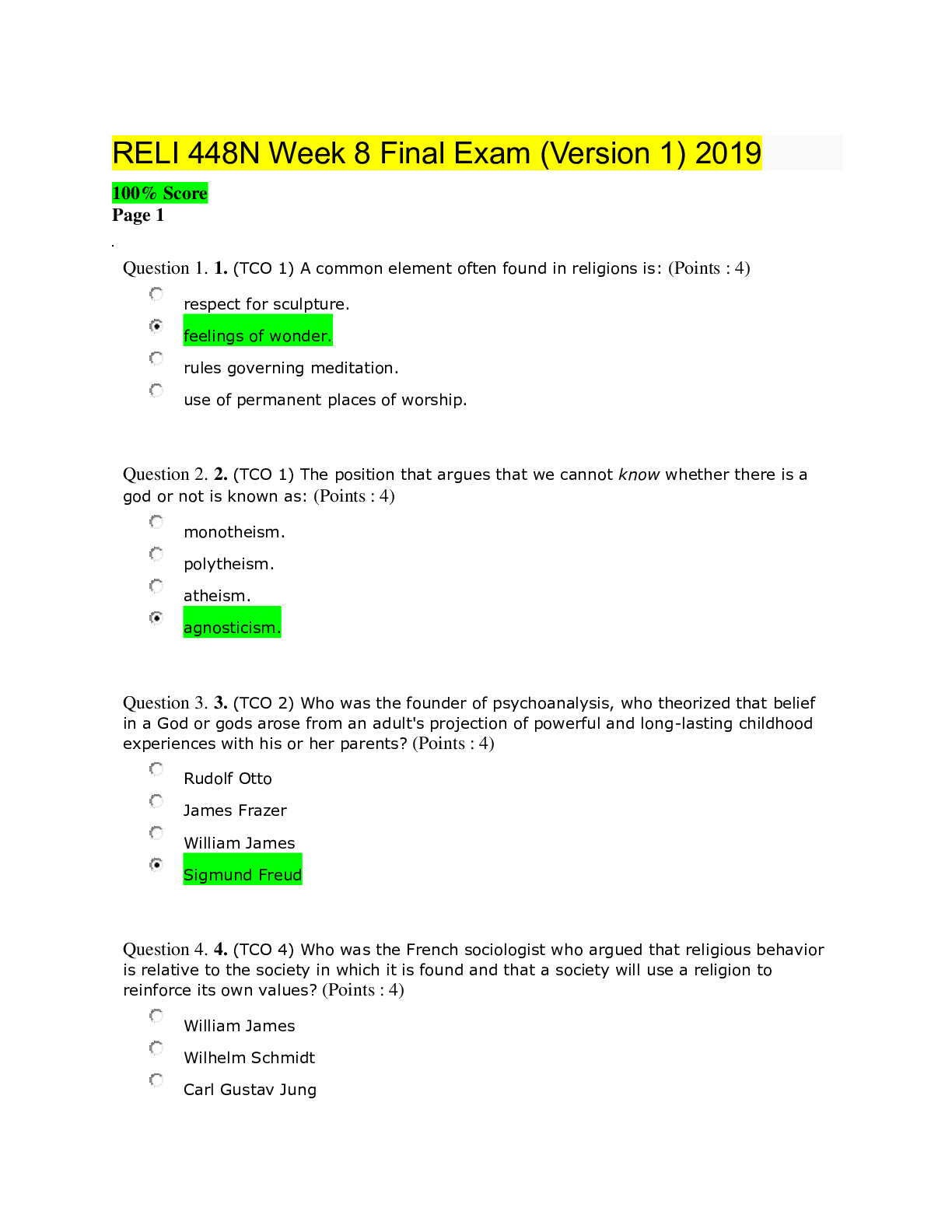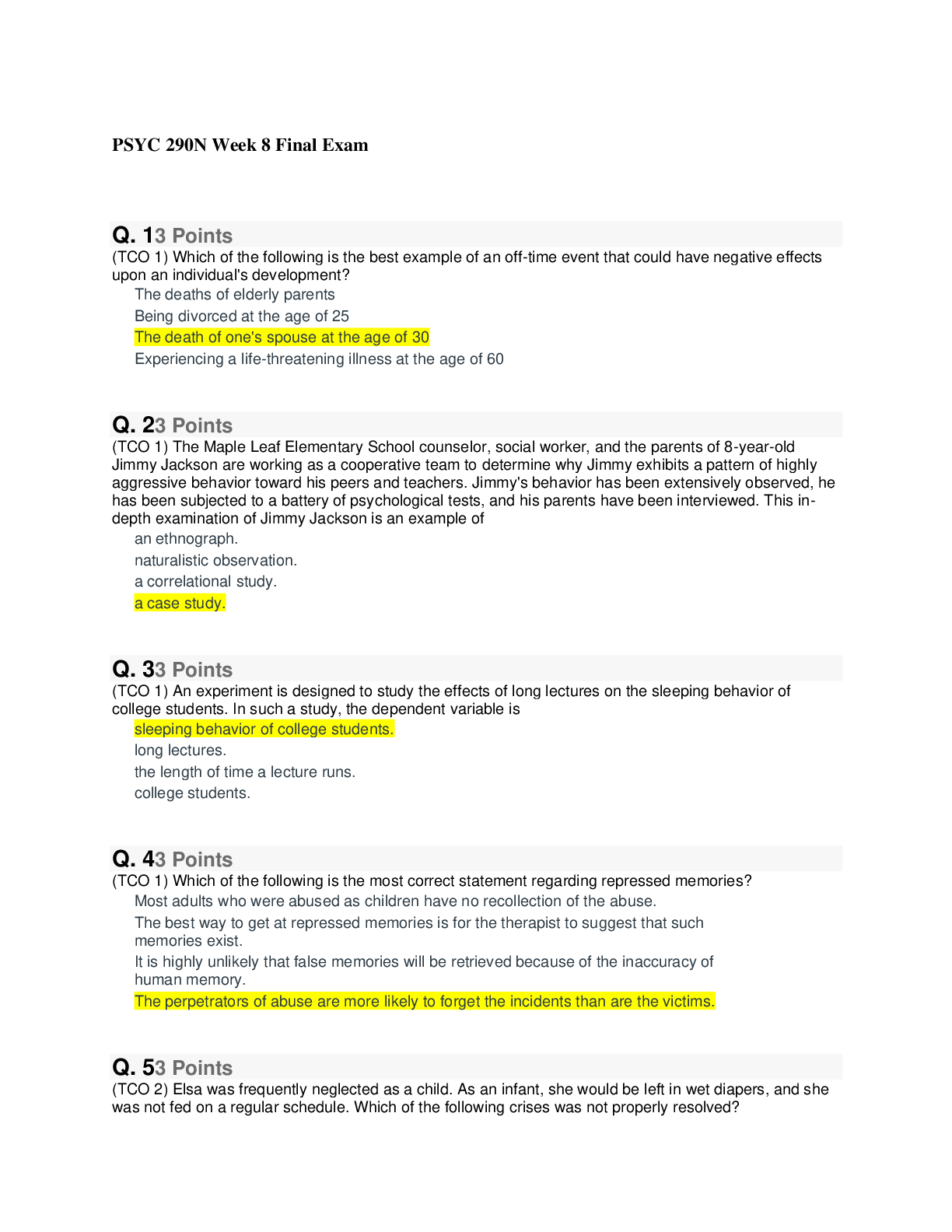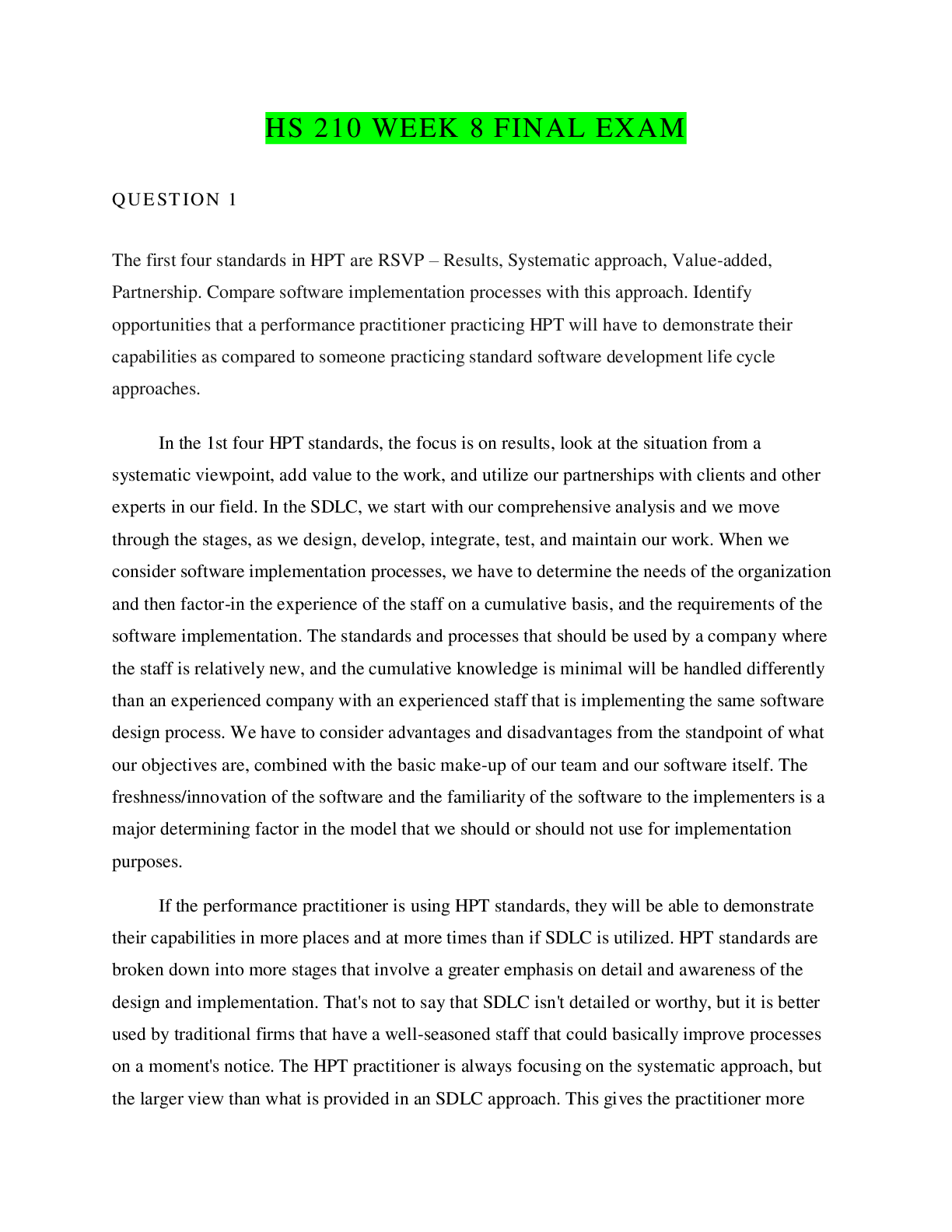Database Management > EXAM > BIS 245 Week 8 Final 5 {GRADED A) EXAM | SCORE 270 Points | 100% SATISFACTION | DeVry University. (All)
BIS 245 Week 8 Final 5 {GRADED A) EXAM | SCORE 270 Points | 100% SATISFACTION | DeVry University.
Document Content and Description Below
WEEK 8: FINAL EXAM Due Sep 2 at 12:59am Points 270 Questions 26 Available Aug 26 at 12:59am - Sep 2 at 12:59am 7 days Time Limit None Allowed Attempts Unlimited Instructions Here is some inform... ation about your Final Exam. It’s time to show your skills and knowledge of what you have learned. The Final Exam covers COs 1–10 and all assigned chapters. The Final Exam is worth 270 points, consisting of the following. 22 multiple choice questions, 5 points each (110 points total) four essay questions, 40 points each (160 points total) Remember to save your answers often. You have 3 hours and 30 minutes to complete the exam. Remember to submit your exam when you are finished. By submitting this work, I am attesting that it abides by the Student Honor Code (https://devryu.instructure.com/courses/899/pages/student-honor-code) . Good luck! Take the Quiz Again Attempt History Attempt Time Score KEPT Attempt 5 49 minutes 110 out of 270 * LATEST Attempt 5 49 minutes 110 out of 270 * Attempt 4 2 minutes 25 out of 270 * Attempt 3 3 minutes 45 out of 270 * Attempt 2 2 minutes 25 out of 270 * Attempt 1 Top 59 minutes 70 out of 270 * * Some questions not yet graded Score for this attempt: 110 out of 270 * Submitted Aug 27 at 12:48pm This attempt took 49 minutes. Correct! Correct! Top (CO 1) Which one of the following tools is the quickest way to create a tabular report in MS Access based on the selected table or query? Report Design tool Report tool options Blank Report tool Correct! Report Wizard tool Correct! (CO 1) A detail line is used to Top print more detailed information on one record only. provide additional field information on a record. Correct! repeat data for each record in the record source. All of the above Correct! Correct! Question 8 5 / 5 pts (CO 3) All of the following are reasons to save first name and last name as separate fields except Correct! fewer fields are used. first name could be used in a salutation. last name could be used in a salutation. you can sort on last name then first name. Correct! (CO 3) Which of the following does NOT apply to the following description of an image? Top Image Description: Three tables are pictured: Table 1: Suppliers with a primary key of SupplierID and fields: CompanyName, ContactName, ContactTitle, Address, City, Region, PostalCode, Country, Phone, Fax, and HomePage. Table 2: Products with a primary key of ProductID and fields: ProductName, SupplierID, CategoryID, QuantityPerUnit, UnitPrice, UnitsInStock, UnitsOnOrder, ReorderLevel, and Discontinued. Table 3: Categories had a primary key of CategoryID and fields: Categoryname, Description, and Picture. There is a relationship labeled 1 attached to Table 1 or suppliers and an infinity symbol attached to Table 2 or products. A one-to-many relationship is applied. The display is showing the design view of relationships. One table is not joined to the other two tables. Correct! A join eT xiospts on two primary keys. Correct! Correct! (CO 5) The foTlloowping are form creation tools except blank form. form design. Correct! form layout. form wizard. Correct! (CO 6) Data aggregate functions are used to perform calculations on individual records in a table or query. Correct! cannot be used on a row. Top perform calculations on entire columns of data. return multiple values. Question 16 5 / 5 pts (CO 9) First normal form can be identified by a row of a table holds data that pertains to one and only one instance. all the entries in a column must be the same data. the order of rows does not matter. Correct! All of the above Question 17 5 / 5 pts (CO 2) Which of the following statements best describes data mining? It is the determining of future volume of sales. It is the predicting of future customer buying behavior. Correct! It is identifying patterns or relationships through a process of analyzing large quantities of data. It is tracking customer purchasing behavior. Top Question 18 5 / 5 pts (CO 8) All of the following describe how a Navigation Form is used except click the create tab and then navigation in the forms group to create a navigation form. Correct! is another term for a specific report. helps users open forms and reports. has the look and feel of a web form. Correct! (CO 9) All of the following describe a digital signature certification authority except a certification authority company provides a digital signature when a high level of security is needed to protect the contents of a database. a certification authority is a commercial company that is highly regulated in most countries. a fee is charged for the service of issuing and validating identities using a digital signature. Correct! certification authority companies establish their own rules and regulations that users must follow. Correct! Correct! Question 23 Not yet graded / 40 pts (CO 1) The department manager has asked you to create a report in Access. What are some of the questions that you would ask to determine what should be on the report? For one of your questions, give an example of two different answers the manager might give, and tell how each answer would affect the report design. Your Answer: you should ask the following questions: 1. What is the purpose of the report? 2. Who will use the report? 3. Which tables are needed for the report? 4. What information needs to be included 5. How will the report be distributed? 6. Will the results be converted to another format? These questions should all be answered before creating a report. Once they have beeTnoapnswered a sketch can be created and a report tool can be chosen. I would say that it's important to make sure that the tables are accurate before pulling information from them other wise the report would be useless. What is the purpose of the report? Who will use the report? What tables are needed for the report? What calculations need to be included? How will the report be distributed? One answer for who will use the report is high-level executives. If this is true, they most likely would want a short, summarized report. If the answer is mid-level managers, then the detail would probably be included, sorted and grouped, with summaries for each group. There are many possible correct answers to this question. See Grauer Textbook Chapter 4. Question 24 Not yet graded / 40 pts (CO 2) The relational model relies on primary keys to identify entities and on foreign keys to create relationships to preserve the integrity (validity) of the keys. Discuss the two rules that ensure the integrity of keys within a database. Your Answer: 1- ENTITY INTEGRITY All primary key entries are unique, and no part of primary key may be null. Each row will have a unique identity, and foreign key values can properly reference primary key values, for example... No invoice can have a duplicate number, nor can it be null. In short, all invoices are uniquely identified by their invoice number. 2- REFERENTIAL INTEGRITY A foreign key may have either a null entry, as long as it is not a part of its table's primary key, or an entry that matches the primary key value in a table to which it is related.(every non –null foreign key value must reference an existing primary key value).It is possible for an attribute not to have corresponding value, but it will be impossible to have an Top invalid entry. for example, A Customer might not yet have an assigned sales representative(number),but it will be impossible to have an invalid sales representative(number) Rule 1: Entity integrity: Every table must have a valid primary key. Entity integrity requires that the designer specify a primary key at the time that the table is created. Because most database products do not enforce entity integrity—it is up to the designer to remember to specify a primary key. Rule 2: Referential integrity: No unmatched foreign key values. Referential integrity requires that foreign key values match existing primary key values in the table to which they refer. Question 25 Not yet graded / 40 pts (CO 4) Describe the insert problem caused by a denormalized design. Your Answer: To answer to this question, (a) one has to define what architecture is and (b)what architecture is expected to do.. Let me define what architecture is: Architecture involves creation of forms and spaces expected to enable the performing of certain functions, which may be intervened by quantitaive dimensions of form and space as much as qualitative characteristics of form and space. Specific people are involved whose previous spatial experiences of the world as well as future expectations have to be accounted for.. (a) A good definition of architecture would thus be, "Architecture is the creation of forms and spaces so as to produce in the participants a definite spatial experience in relation to the previous and anticipated spatial experiences".. (b) As can be seen, architecture is expected to produce definite spatial experiences.. The question 'what is an architectural design problem' pre-suppopses that architecture is a problem solving activity. In that context, we may ask, what is the purpose of creating spatial experiences ?T oorpwhich problem will the spatial experiences will resolve ? That indeed is the architectural design problem.. If we look at architecture as a problem solving exercise, it deals with numerous problems. Among them are problems of site, problems of context, problems of structure, problems of climate, problems of internal environmental controls such as airconditioning etc. as well as mecahnical problems etc. Although a building deals with them, they are essentaily not the core of the architecture. As per our definition, creating a spatial experiences is made possible by these and they create their own problems. But they are not the critical architectural problems.. The architectural problems are the ones that can be affected or resolved by the spatial experiences; which undeniably are social and psychological by nature. Thus the archiectural problems are those social and psychological aspects of 'being in' and 'using a piece of architecture' for the 'purpose for which that piece of architecture is intended'. By purpose, this means not the mundane function of a space but the underlying deep rooted, social and psyhological conditiions required for the performance of that function.. An Architectural design problem therefore is the social/psychological condition necessary to be acquired by a user in order to perform the major/ the most significant activity of a given project. A project has more than one architectural design problem and they can be recognised as primary and secondary ones, depending on the nature of the functions and activities expected to be carried in a given project. In a denormalized database design, a problem might occur in an update operation because data, which should be stored in its own entity, is unavailable. For example, a student might be required to concurrently register for a class. In other words, a student might not be able to register unless he or she also simultaneously signs up for a class. This might not appear to be such a problem on paper, but in reality, human nature is such that we want to make incremental progress, and just getting registered provides a plethora of perks. So, if the database system requires classes, students will register and sign up for bogus classes. As a result of a poorly designed and implemented database, many users will feed the database erroneous data, which they may not go back and subsequently correct. Even if they do, administrators may rely on the temporary information to attempt to staff for essentially phantom enrollments. Top Question 26 Not yet graded / 40 pts (CO 4) If you were given an ERD that contained a M:N relationship between orders and products, what would you need to do in order to create the tables and relationship in Access? Your Answer: A many-to-many relationship can be best defined by an example. Let's say you have a Products table and an Order table. The products table has many products, and the order table has many orders. You can have the same product on many orders, and you can have many orders for the same product. This is a many-to-many relationship. To define that relationship in Access, you need to create a third table. This is often referred to as a junction table. A junction table breaks down the many-to-many relationships into two one-to-many relationships. Place the primary key from each of the tables into the third table. This results in the third table recording each instance of the relationship. You would need to create an associative (linking, junction) table (perhaps called OrderLine) between orders and products so that you would have two 1:M relationships. One relationship would be connected from orders to OrderLine and one from products to OrderLine. This topic is covered in Lab 3 and 4, and is discussed in Chapters 2 and 3 of the Frost textbook. Quiz Score: 110 out of 270 Top [Show More]
Last updated: 2 years ago
Preview 1 out of 16 pages

Buy this document to get the full access instantly
Instant Download Access after purchase
Buy NowInstant download
We Accept:

Reviews( 0 )
$14.50
Can't find what you want? Try our AI powered Search
Document information
Connected school, study & course
About the document
Uploaded On
Nov 17, 2021
Number of pages
16
Written in
Additional information
This document has been written for:
Uploaded
Nov 17, 2021
Downloads
0
Views
89



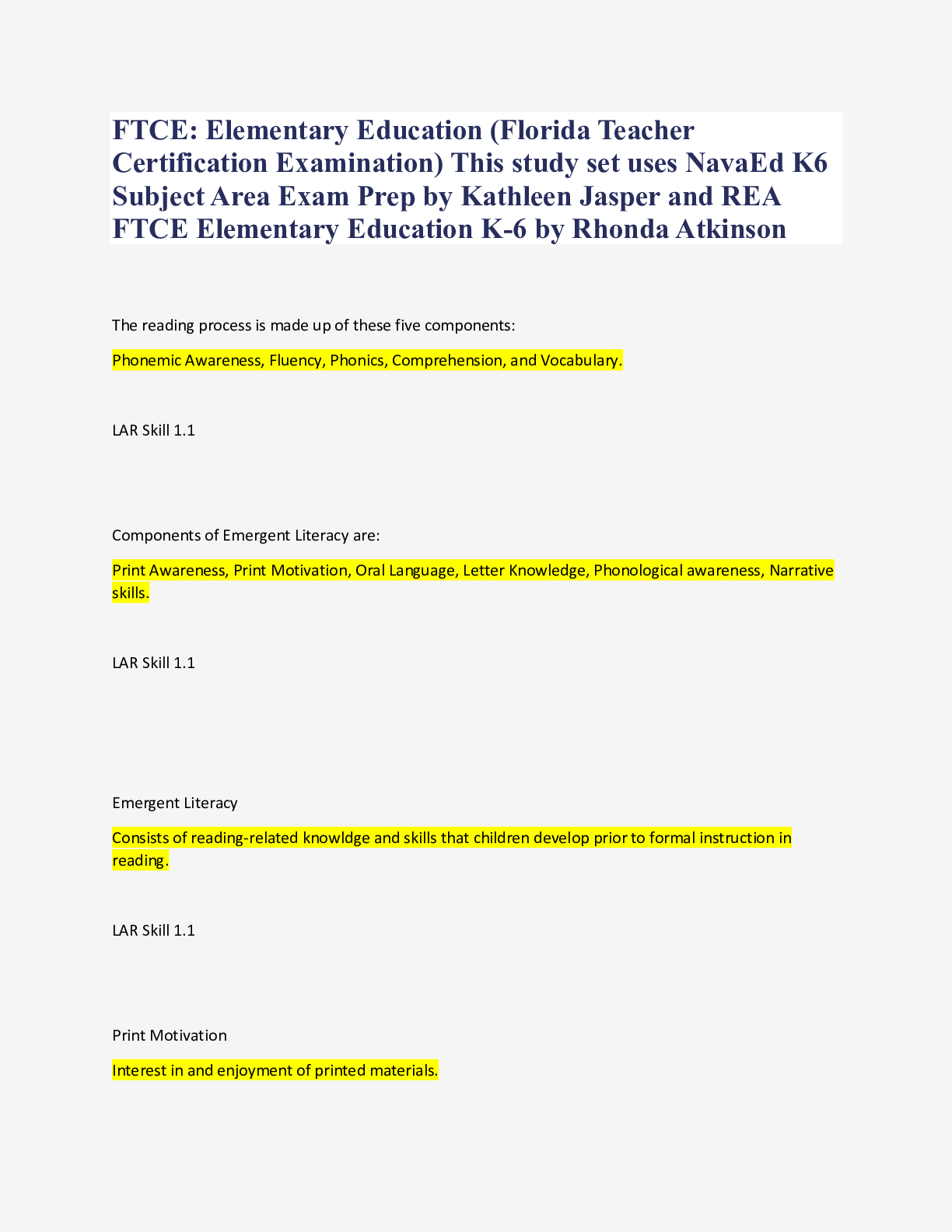

 Questions and Answers 100% VERIFIED.png)
 Questions and Answers 100% correct Solutions.png)



